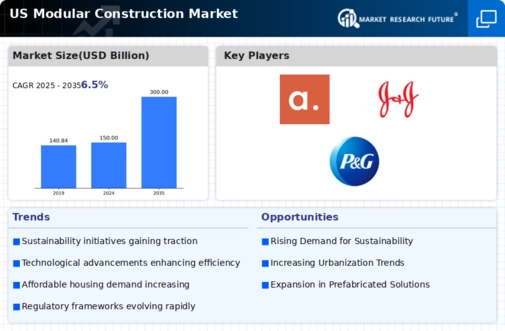The modular construction market is currently characterized by a dynamic competitive landscape, driven by increasing demand for efficient building solutions and sustainable practices. Key players such as Katerra (US), Factory OS (US), and Guerdon Enterprises (US) are at the forefront, each adopting distinct strategies to enhance their market positioning. Katerra (US) has focused on integrating advanced technology into its construction processes, aiming to streamline operations and reduce costs. Factory OS (US) emphasizes modular housing solutions, targeting the affordable housing sector, while Guerdon Enterprises (US) leverages its expertise in large-scale modular projects to cater to commercial and multifamily developments. Collectively, these strategies contribute to a competitive environment that prioritizes innovation and operational efficiency.
In terms of business tactics, companies are increasingly localizing manufacturing to mitigate supply chain disruptions and enhance responsiveness to regional demands. The market appears moderately fragmented, with several players vying for market share, yet the influence of major companies is palpable. Their collective efforts in optimizing supply chains and enhancing production capabilities are reshaping the market structure, fostering a more competitive atmosphere.
In October 2025, Katerra (US) announced a strategic partnership with a leading technology firm to develop AI-driven construction management tools. This move is likely to enhance project efficiency and reduce timelines, positioning Katerra (US) as a leader in tech-driven modular solutions. The integration of AI into their operations may significantly improve decision-making processes and resource allocation, thereby increasing their competitive edge.
In September 2025, Factory OS (US) launched a new line of modular units specifically designed for urban infill projects. This initiative reflects a strategic pivot towards addressing the growing need for housing in densely populated areas. By focusing on urban solutions, Factory OS (US) is likely to capture a larger share of the market, appealing to municipalities seeking rapid housing solutions.
In August 2025, Guerdon Enterprises (US) secured a major contract for a multifamily housing project in California, showcasing its capability to handle large-scale developments. This contract not only reinforces Guerdon's (US) market position but also highlights the increasing acceptance of modular construction in mainstream real estate development. Such high-profile projects may serve to further legitimize modular construction as a viable alternative to traditional building methods.
As of November 2025, the competitive trends in the modular construction market are increasingly defined by digitalization, sustainability, and the integration of advanced technologies. Strategic alliances among key players are shaping the landscape, fostering innovation and collaboration. The shift from price-based competition to a focus on technological advancement and supply chain reliability is evident. Companies that prioritize innovation and sustainable practices are likely to differentiate themselves in this evolving market, suggesting a future where competitive advantage hinges on adaptability and technological prowess.














Leave a Comment